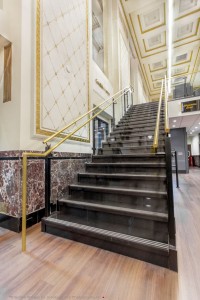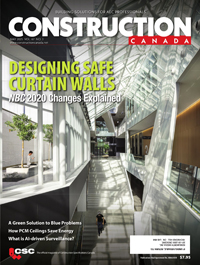The Right Restoration Fit: Balancing heritage requirements with modern fitness club amenities

Protecting the marble floors and walls was one of the key building challenges. As a protected heritage building, nothing could be fastened to the original marble floors or walls, hand-painted wall panels, or plaster ceilings and mouldings. This posed a challenge when it came to building typical management offices. Instead, GoodLife invested in a self-supporting wall system that incorporated power and data. The team assembled the club’s management and sales offices using this type of system, including built-in office furnishings like desks and cabinets.
A fitness club requires robust fresh air and cooling systems, but the team found they could not fasten cooling equipment to the original ceiling or walls. Instead, new fan coil units were installed in the existing marble and brass hot-water radiant heater surrounds. Missing pieces of brass were replaced with new custom brass panels that closely matched the building’s character. The team also installed new wall fans resembling the original style. New floor-mount units were installed in the basement area to accommodate the group exercise room and locker rooms while maximizing the ceiling heights.
Another challenge was transforming the bank basement to an upscale member area. For this flagship club, the plan was to upgrade the locker rooms, washrooms, and shower areas to provide a more comfortable and upscale private club atmosphere.
The construction team stripped back the old plaster ceilings in some areas of the lower level to expose the original structure, which allowed them to recess the light fixtures and increase the ceiling height. Although the ceilings were not designated as ‘heritage,’ the safes were, so the team was required to get approval before they could start any of the work. They incorporated the vaults into the club’s unique design.
The original vault doors have been permanently pinned in an open position and one of the vaults is now a rental locker room for members to store their personal belongings. The other vault was converted to a men’s washroom. Since its walls, floor, and ceiling are 0.6 m (2-ft) thick, cutting through to make an entrance to a washroom took two weeks. Creating openings in the concrete for the plumbing also proved to be difficult.
Ireland and van Haeren also encountered many challenges as part of the restoration. In many cases, there were delays because of heritage requirements they did not anticipate. Looking back, they say out-of-the-box thinking and teamwork were essential to overcoming issues throughout the project. Their best advice is to do lots of research before embarking on a historic restoration.
Key lessons
Never underestimate the challenges and costs associated with a project of this nature. The restoration process uncovered both opportunities and challenges to be carefully addressed. There was nothing routine or predictable about this heritage building and so the regular rules did not apply.
Sufficient time should be allowed to solve unexpected construction challenges. This includes finding trades that can do custom work, and long lead times to have specialized items delivered.
A longer-than-usual timeframe should be expected to obtain building permits and heritage approvals. When the building is not to current code, extra time is required to develop methods and materials to bring it up to code while maintaining the heritage aspects.







